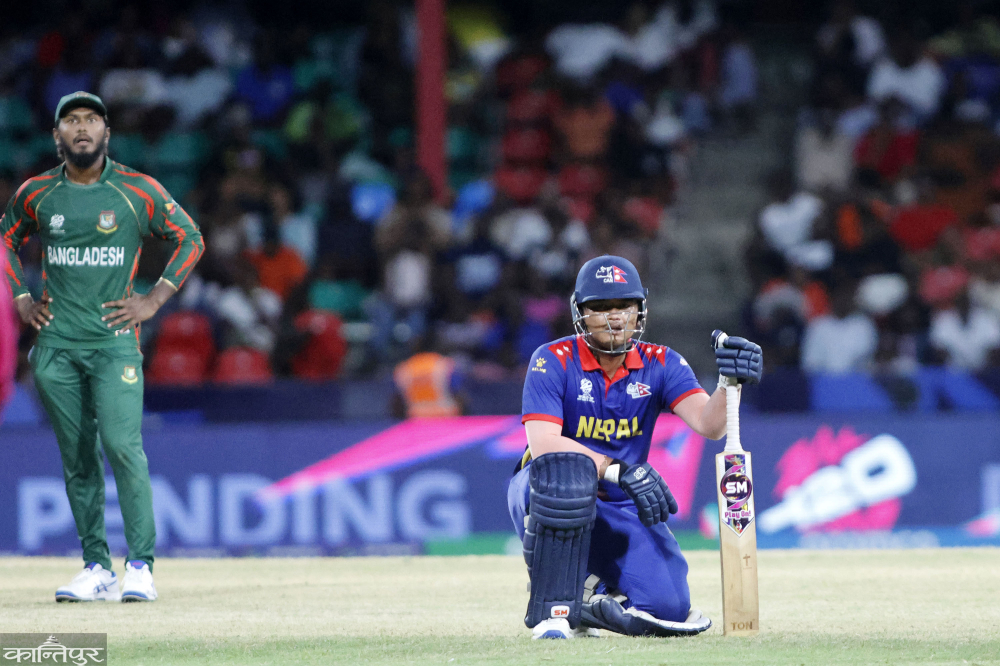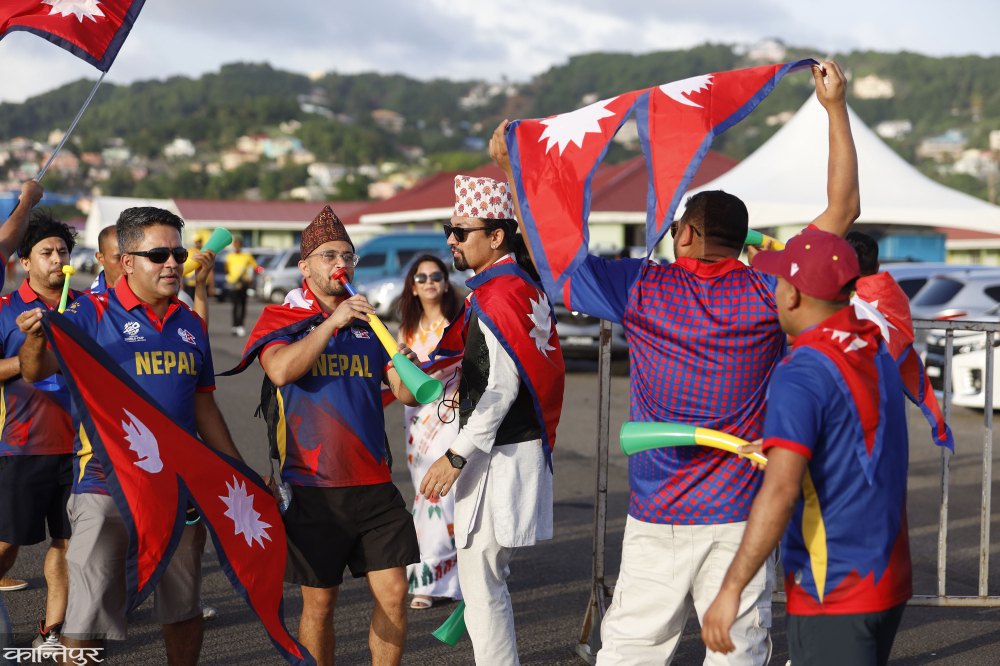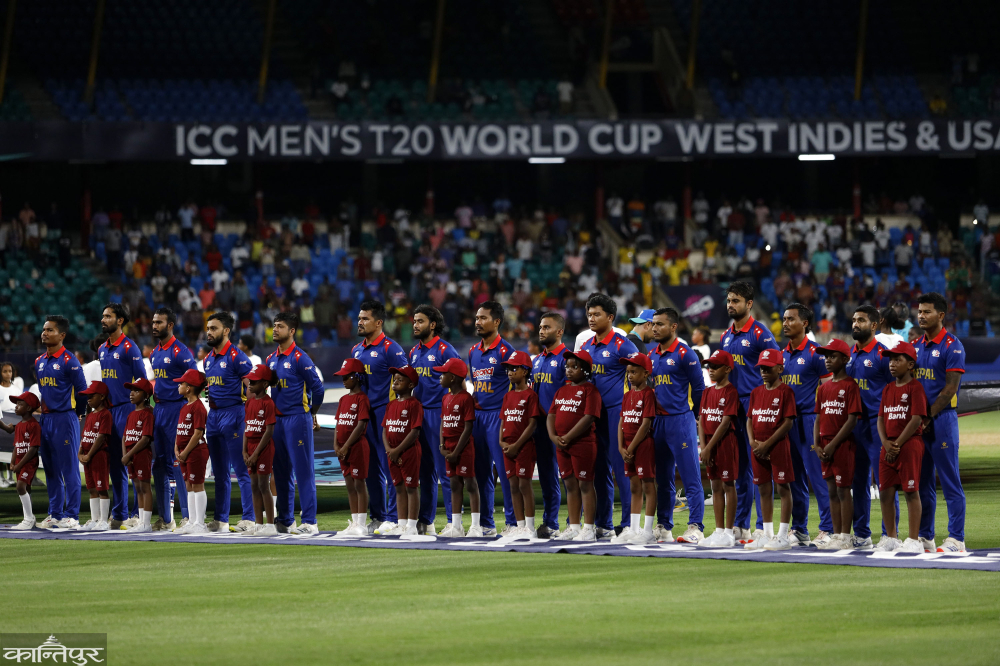Nepali Cricket Festival in the Caribbean

We use Google Cloud Translation Services. Google requires we provide the following disclaimer relating to use of this service:
This service may contain translations powered by Google. Google disclaims all warranties related to the translations, expressed or implied, including any warranties of accuracy, reliability, and any implied warranties of merchantability, fitness for a particular purpose, and noninfringement.

Highlights
- The message of Nepal's combative performance at the Arns Vale stadium was that a fair like World Cup cricket is no longer foreign.
- At night floodlights illuminated Arns Vale. Prime Minister Ralph Gonsalves faced a lot of criticism for hosting the Cricket World Cup with floodlights on when electricity supplies were scarce.



Arns Vale, 4 km from Kingstown, the capital of Saint Vincent and the Grenadines, became a hotspot for cricket lovers six weeks ago. The Twenty-20 World Cup being held on this small island in the Caribbean took Nepali cricket almost 9,000 miles away from Kathmandu.

Although not as busy as in Kingstown, the cricket stadium of Arns Vale, which looked like a village, was colored by Twenty-20 World Cup cricket. One of the six venues in the West Indies, this World Cup venue was different in many ways. Nepal gave a message of comeback by competing in the World Cup after ten years at Arns Vale Stadium. The combative performance that Nepal showed, tried to convey the message that a fair like World Cup cricket will not become a stranger anymore.
The Ring Road from Argyll International Airport was almost complete after wearing a Funko. One side of the ring road almost touches the sea. Argyll International Airport is newly built. The runway of the former ET Joshua Airport on the right side of the Caribbean Ocean is now inside Arns Vale Stadium, which has been converted into a car park. The sea on one side, the hills on the other and the old runway on the other side make Arns Vale Stadium one of the most picturesque stadiums in the world. The story of its construction is no less than the under-construction Moolpani Cricket Stadium in Nepal. Its construction was started in 1972 and it was commissioned almost 10 years later. The match between Netherlands and Bangladesh on June 13 was the first match played at this stadium since 2013.

The next day, on June 14, the match between Nepal and South Africa was the first match to be played at this ground under floodlights. Floodlights lit up the stadium at night illuminated Arns Vale. Floodlights, double-decker media box, pavilion, president's box and other facilities were added to this stadium for hosting the World Cup. It was only after adding all these facilities that the Arns Vale Stadium became eligible to host the World Cup. Why not protest for the sake of protest? Arnus Vail also did not remain untouched in this context. 5 days before Nepal's match against South Africa, St. Vincent became dark due to 'blackout'. Prime Minister Ralph Gonsalves had to listen to a lot of criticism saying that the World Cup cricket was held with floodlights in the absence of electricity sources. There was a banner news about this on the front page of tabloid newspaper 'The Vincentian'.
With the start of the World Cup cricket match, the 18,000-capacity Arns Vale stadium was half-full, and these criticisms were becoming more and more intense. A large number of spectators flocked to St. Vincent to watch their respective countries play, giving a huge boost to the tourism industry there. Those spectators were about to board a speed boat and go to different islands there. Around 500 Nepali spectators from different places came to St. Vincent to watch their team's game. 38 million EC (about $14 million) was spent on upgrading Arns Vale Stadium. Prime Minister Gonsalves had his own reasons for this. “It's not about dollars and cents, it's about the youth of this country. Especially for those who watch sports and wish for the overall growth and development of our civilization,' the media quoted Gonsalves as saying.
There was as much curiosity as going to the Caribbean region, which has a rich culture of world cricket, but there was also fear. Introduced as a major tourist destination, the Caribbean region is also notorious for criminal activity. Those who knew us and understood the situation there also advised us not to go out alone, not to carry mobile phones and purses if we had to go out. All this confusion was shattered when we reached St. Vincent. Prime Minister Gonsalves himself was sitting on the parapet watching the World Cup matches. Nepali supporters Madhukar Rajbhandari, Vijayaman Shrestha dressed Prime Minister Gonsalves in a Dhaka cap and placed the Nepali flag on his shoulders. There was no 'protocol' during that time, nor did any security personnel come and try to stop it. Madhukar, an old player of Thamel, came from Kathmandu and Vijayaman with his son Sawis came from America to watch the match in Nepal.

It was almost midnight when I reached my accommodation after 15-20 minutes from the stadium and there was nothing to fear. It was a surprise to meet former West Indies batting legend Richie Richardson in an ordinary bar near the stadium. The speech of the locals, including him who was there in the role of match referee, was very humble. In a way, St. Vincent felt like 'Rama Rajya'. They used to go out with the windows and doors of the house open. Incidents of theft and gangsterism became a foreign matter. Since it was mango season, someone picked mangoes from the tree in front of the house, but no one said anything. We all had a good dose of mango picked from another's house.
A total of 5 World Twenty20 matches were held in St. Vincent. Afghanistan created a sensation by reaching the semi-finals by defeating Australia and Bangladesh here. There were various reasons for the return of cricket to St. Vincent, that too the World Cup. One is the 40-year-old Kishore Salow, the president of West Indies Cricket. He himself belonged to St. Vincent. Another was the Jamaican cricket controversies. Along with St. Vincent, the World Cup was being played in Antigua, Barbados, Guyana, St. Lucia and Trinidad and Tobago. While not a single match was played in Jamaica, the biggest island of cricket. The famous Sabana Park was empty. Jamaican Rovman Powell is the captain of the West Indies Twenty20 cricket team. He did not get to play a single match at home in the World Cup. Usain Bolt, the great runner of world athletics, was made the 'Ambassador' of the Twenty-20 World Cup by the International Cricket Council (ICC). He was also disappointed that there was no World Cup match in his hometown. No Caribbean Premier League matches have been played in Jamaica since 2019. From Michael Holding, Jeff Dujon, Courtney Walls, Jimmy Adams, Twenty20 international top scorer Chris Gayle to Marlon Samuels, Andrew Russell, Jamaica's cricketing politics has become a new destination for St. Vincent cricket.
Nepal played their last two matches of the group stage in St. Vincent. Before the match against Nepal, South Africa had won the first three matches and reached the Super Eight and this was the team's last match in the group stage. Probably because South Africa had reached the previous stage, only one South African journalist was found in the media box. All the others had gone to the venue of the Super 'eight' match. Journalists from Nepal and Bangladesh filled the media box at Arns Vale. After the next match against South Africa, Nepal was playing against Bangladesh two days later.
Nepal had a very energetic bowling performance against South Africa. The Bangladeshi journalists who were there were also repeating 'Excellent', 'Beautiful', 'Quarterfinal-Quarterfinal' in praise of the Nepalese team. If Nepal defeated South Africa, the match against Bangladesh would be like a knockout. In that equation, Bangladeshi journalists estimated that the match between Nepal and Bangladesh would be like a quarterfinal.

If the Nepalese team had shown a little 'hunger for victory', a great history would have been made on this ground. Despite bowling out South Africa for 114 runs, Nepal could not chase down the victory target and South Africa won by 1 run. If Gulshan Jha had hit the last two balls of the bat or if Gulshan had run a little faster in the last ball of the game, if the umpire had given a no ball to a ball that went over the shoulder like Otneil Bartman of South Africa, etc., etc., Nepali supporters are still tired of counting. However, a big tournament like the World Cup was a great opportunity for Nepal to gain experience. Asif Shaikh, the opening batsman of the Nepali team, said, "After playing in the World Cup, now Nepal has become an environment of confidence that they can play with that level of team." However, victory was far away for Nepal and they were forced to accept a 21-run defeat. During the preparation of the World Cup, Nepal has not seen some weaknesses since the beginning. The selection of players seemed to be of a province. An example of this was in the match against Bangladesh. Apart from the playing 11, the remaining 5 players were all bowlers. Six medium and fast bowlers were placed in the Nepali team on the wickets of America and West Indies, which are considered to be helpful for spin. The only change in Nepal's game was that South Africa replaced Keshav Maharaj with Tabriz Samsi and he took 4 wickets to shatter Nepal's dream of defeating the Test nation. After this match with Nepal, South Africa's captain Aiden Makram said that after Samsi's performance, the composition of his team's playing 11 will change. Samsi was going to play in place of Bartman, who saved South Africa from defeat by Nepal by conceding only 6 runs in the last over. Nepal did not try to get out of the same set team.
The left-handed spinner dominated the tournament. Samsi was not alone in this. India, the champions, played three left-arm spinners, Ravindra Jadeja, Akshar Patel and Kuldeep Yadav in almost all the matches throughout the tournament. Sagar Dhakal and Lalit Rajvanshi from Nepal were two left-arm spinners in the team. Sagar got an opportunity in a match against the Netherlands. Despite not taking a wicket, he bowled cheaply against the Netherlands and did not get another chance after that. Lalit, who went to America and West Indies as Nepal's main spinner, returned as a "tourist" without playing a single game. The Nepali team was already lost when they reached Dallas from St. Vincent and Houston through Florida, USA. Their performance in the practice match against Canada was proof of that. The management team of Nepal Cricket Association was very wrong in this matter.
The United States, which is hosting the World Cup for the first time, was seen as the best in terms of the project. None of the warm-up games played in Dallas, one of three cities hosting the World Cup, were televised or streamed live. The media was also barred from photographing the game, only allowed to watch and write about it, as construction work continued. A large number of Nepalese spectators reached the Perry View Cricket Stadium in Dallas to watch the match between Nepal and Canada. However, the volunteers at the gate were turning away the spectators who reached the gate saying that the stadium was full of spectators, while the match was played in an empty stadium.
The condition of the pitch in New York made the ICC think. A temporary structure was built in New York at a cost of $42 million. It was demolished after the World Cup games in America. 3 matches in Lauderhill, Florida, which is considered the cricket capital of America, were canceled due to rain. It was only natural that the games would be canceled after hosting the World Cup at the onset of the monsoon in rainy Florida. Outside the cricket stadium in America, there was not much excitement about the World Cup. As much as it was only in Nepal's matches and matches between India and Pakistan.

After flying to the West Indies, the atmosphere of cricket could be felt in the ship. Official Airlines Caribbean revealed the significance of hosting the World Cup by featuring Andrew Russell on the front page of their 'Inflight' magazine. Brian Lara's home country of Trinidad had World Cup stickers plastered on the floor. When arriving from Trinidad to Barbados, the dummies of Gary Sobers, Malcolm Marshall and other players were placed near the welcome gate inside the airport.
I was listening very attentively when the pilot of the flight from Trinidad to Barbados was introducing himself. My interest in the introduction of the Caribbean Airlines pilot was due to former West Indies cricketer Colin Croft. 3 and a half decades ago, the news of him becoming a pilot from a cricketer was published. Croft has also given a strong performance at St Vincent's. At that time, Croft took 6 wickets in 2 ODIs when St. Vincent's hosted Akkalzhukkal internationals.
The pilot introduced himself as Hariprasad stating that the flight of ATR 72 from Trinidad to Barbados was 1 hour. A large number of citizens of African and Indian origin have settled in the West Indies. West Indies cricketers like Shivnarayan Chandrapal, Ramnaresh Shravan, Darren Ganga used to take their grandmother with Gangajal when they came to play in India. Probably Hariprasad also belonged to this environment. On the way back from St. Vincent en route to Trinidad, the ship was also ATR 72. I was listening intently to see if the pilot would say his name Croft again this time. "I am Captain Shyam Prasad, welcome to Caribbean Airlines," the pilot said about the trip.
file photos

 प्रकाशित : श्रावण १२, २०८१ ०९:१९
प्रकाशित : श्रावण १२, २०८१ ०९:१९

 २२.१२°C काठमाडौं
२२.१२°C काठमाडौं











